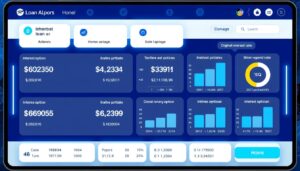What if the key to unlocking financial opportunities isn’t just borrowing money—but understanding how loans truly work? In America, 43% of households carry debt linked to credit vehicles like mortgages or personal financing. Yet many struggle with concepts like compound interest or how lenders evaluate creditworthiness.
A loan allows individuals to access funds upfront in exchange for repayment plus interest. The principal amount forms the base, while interest—calculated as simple (fixed on principal) or compound (interest on interest)—determines the total cost. For example, a $10,000 personal loan at 7% annual interest could cost $700 yearly without compounding.
Lenders analyze three pillars: credit score, income stability, and existing debt. A 680+ FICO score often qualifies borrowers for better rates, while high debt-to-income ratios raise red flags. Secured loans (like mortgages) require collateral, while unsecured options rely solely on credit history.
This guide breaks down loan structures, application processes, and strategies to secure favorable terms. Whether financing a home or consolidating debt, understanding rates, repayment timelines, and lender expectations empowers smarter decisions.
Overview of Loans in the U.S.
Loans fuel everything from buying homes to launching startups, acting as the backbone of American economic activity. Over 80% of businesses use credit facilities to manage cash flow or expand operations, while individuals rely on financing for education, vehicles, and unexpected expenses.
Financial institutions offer two primary categories: secured and unsecured loans. Mortgages and auto financing require collateral like property or vehicles. Credit cards and personal loans depend on a borrower’s credit score and income stability. Lenders evaluate applications using three metrics: payment history (35% of FICO scores), current debt levels, and employment status.
Interest rates significantly impact affordability. A 1% difference on a 30-year mortgage could save $20,000 over the loan term. Fixed-rate options provide predictable payments, while variable-rate loans might offer lower initial costs.
Borrowers should compare terms from multiple lenders. Credit unions often provide lower rates than traditional banks, especially for members with strong credit profiles. Pre-approval processes help estimate monthly payments without affecting credit scores.
Understanding these fundamentals prepares consumers to navigate lending options effectively. The next sections detail specific loan structures and strategies to secure favorable conditions.
What Is a Loan?
A loan is a formal agreement where a lender provides money to a borrower, who repays the amount plus interest over time. Investopedia defines it as “a form of debt incurred by an individual or entity,” structured through legally binding terms. This arrangement allows people to finance large purchases or consolidate debt while lenders earn through interest charges.
The process begins with an application detailing income, employment, and credit history. Approved borrowers receive funds after signing a contract outlining repayment schedules, interest rates, and fees. Most agreements specify whether interest is simple (fixed on the original amount) or compound (applied to accumulated balances).
Secured loans require collateral like homes or vehicles, which lenders can claim if payments stop. Unsecured options like personal loans rely solely on creditworthiness. For example, mortgages use property as collateral, while credit cards operate as revolving lines of credit without asset backing.
Lenders assess risk through credit scores and debt-to-income ratios. A 680+ FICO score typically qualifies for better rates. Payment timelines vary—auto loans often span 5 years, while mortgages might extend to 30 years. Understanding these components helps borrowers compare offers and avoid unmanageable debt.
Understanding Different Types of Loans
American borrowers face a maze of credit options, each designed for specific financial goals. Loans fall into two main categories: secured and unsecured. Secured options like mortgages or auto financing require collateral—physical assets lenders can claim if payments stop. For example, a $300,000 home loan uses the property itself as security, often resulting in lower interest rates.
Unsecured loans rely on creditworthiness rather than collateral. Personal loans and credit cards fall here, with approval depending on income and credit scores. A borrower with a 720 FICO score might qualify for a $15,000 personal loan at 9% interest, while someone below 600 could face rates above 20%.
Another key distinction involves repayment structures. Term loans provide fixed amounts repaid through scheduled monthly payments. Auto loans typically follow this model. Revolving credit, like home equity lines (HELOCs), allows repeated borrowing up to a limit—similar to a credit card’s flexibility.
Interest rates vary by risk. Secured loans often have lower rates due to reduced lender risk. Unsecured options compensate for higher risk with steeper rates. A 30-year mortgage might carry 6% interest, while an unsecured personal loan could hit 12% for the same borrower.
Choosing the right type impacts long-term costs. A $25,000 car loan at 5% over five years costs $2,904 in interest. Using a credit card at 18% for the same amount would triple interest payments. Understanding these differences helps align borrowing with financial capacity and goals.
Know About Loans: Key Components and Processes
Navigating loan agreements requires grasping core elements that shape borrowing costs and obligations. Every credit arrangement includes a principal amount, which is the initial sum borrowed. Interest—either simple or compound—determines how much extra borrowers pay over time. For example, a $200,000 mortgage with a 5% fixed rate accumulates $10,000 in annual interest before principal reductions.
Lenders evaluate applications using three factors: credit history, income stability, and existing debt. A 720 FICO score often unlocks lower rates, while a debt-to-income ratio above 40% may trigger rejections. Documentation like pay stubs, tax returns, and bank statements verify financial capacity.
Fees add hidden costs. Origination charges—typically 1-6% of the principal—are deducted upfront. A $20,000 personal loan might incur $1,200 in fees before disbursement. Collateral requirements vary: mortgages use property, while unsecured options like credit cards rely solely on creditworthiness.
The approval process follows five steps: application submission, document review, credit checks, terms negotiation, and fund disbursement. Auto loans often finalize within days, whereas mortgages take 30-45 days due to appraisals and title searches.
Repayment terms depend on the loan type. A 60-month car loan at 6% interest creates $386 monthly payments on $20,000 borrowed. Understanding these components helps borrowers compare offers and avoid financial strain.
Loan Interest Rates and Repayment Strategies
Why do two borrowers pay vastly different rates for similar loans? Lenders set interest based on credit scores, income stability, and broader economic factors like the federal funds rate. A 720 FICO score could secure a 7% rate on a personal loan, while a 620 score might trigger 15%—doubling total repayment costs.
Simple interest calculates charges only on the original principal. A $10,000 loan at 8% simple interest costs $800 annually. Compound interest adds fees to the updated balance monthly or yearly, increasing total debt faster. For example, that same $10,000 with monthly compounding grows to $10,839 in one year.
Repayment strategies matter. Paying $100 extra monthly on a $20,000 credit card balance at 18% saves $4,200 in interest and cuts the term by 4 years. Refinancing high-rate debt when credit improves also helps. Switching from a 12% personal loan to 8% reduces monthly payments by $33 on a five-year $15,000 loan.
Borrowers should prioritize loans with compound interest first. Automating payments avoids late fees, and biweekly mortgage payments (26 half-payments yearly) shave years off repayment timelines. Always verify rate types—fixed stays steady, while variable rates fluctuate with market indexes.
💡 Essential Documents for Loan Application: What You Need to Know
Tips for Getting and Managing a Loan
Smart borrowing starts with preparation and precision. Before applying, review your credit report for errors and pay down existing balances. A 100-point credit score improvement could slash interest rates by 3% on a personal loan, saving thousands over time.
Compare offers from at least three lenders. Credit unions often provide lower rates than traditional banks. Focus on the annual percentage rate (APR), which includes fees and interest. A $10,000 loan at 8% APR costs $1,200 less than one at 12% over five years.
Lenders prioritize income stability and debt-to-income ratios. Keep this ratio below 36% by paying off credit cards or consolidating debt. Automate payments to avoid missed deadlines, which can trigger penalties or credit score drops.
Read every contract clause. Some agreements include prepayment penalties or variable rates that spike after introductory periods. Refinancing high-interest debt when rates drop or credit improves can reduce monthly payments by 20-30%.
Track repayment progress using budgeting apps. Allocate windfalls like tax refunds to principal reductions. Building an emergency fund prevents reliance on high-cost borrowing for unexpected expenses.
Conclusion
Mastering loan fundamentals transforms financial decisions from stressful puzzles to strategic opportunities. This guide explored how secured and unsecured credit options work, emphasizing factors like interest calculations and credit score impacts.
Choosing between fixed-rate mortgages or variable-rate credit cards requires understanding long-term costs. Comparing offers from multiple lenders often reveals better terms, while timely payments protect credit health.
Effective debt management starts with clear repayment plans and budgeting tools. Small steps—like reviewing credit reports annually or negotiating rates—can save thousands over time.
Financial empowerment comes from informed choices. By applying these insights, borrowers can secure favorable terms, avoid common pitfalls, and align borrowing with personal goals.




